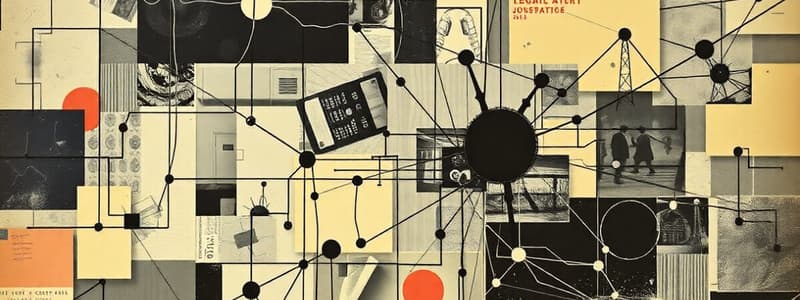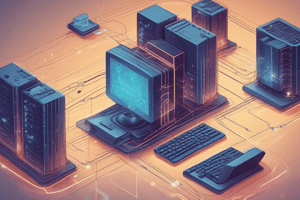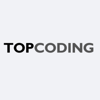Podcast
Questions and Answers
Which of the following best describes the primary function of a Domain Name Server (DNS) in a networked environment?
Which of the following best describes the primary function of a Domain Name Server (DNS) in a networked environment?
- To host and fulfill requests from client devices
- To translate domain names into IP addresses for device communication (correct)
- To send emails from one client to another
- To prevent unauthorized access into and out of a computer network
In the context of system design, what is the significance of 'iteration' during the design process?
In the context of system design, what is the significance of 'iteration' during the design process?
- It eliminates the need for end-user involvement in the design process.
- It ensures that the design is completed in a single attempt without any revisions.
- It allows designers to step back, reconsider choices, and steadily improve the design based on evaluation and testing methods. (correct)
- It guarantees that the final product will have no usability problems.
Which of the following is a primary goal that a modern information system should be planned to achieve?
Which of the following is a primary goal that a modern information system should be planned to achieve?
- Increase client trust and brand strength (correct)
- Minimize data security protocols
- Maximize hardware expenses
- Reduce organizational resiliency
What is the 'Hawthorne effect' in the context of direct observation of current procedures?
What is the 'Hawthorne effect' in the context of direct observation of current procedures?
What does 'integrity' refer to regarding data?
What does 'integrity' refer to regarding data?
In the realm of computer networks, what role does a 'router' primarily fulfill?
In the realm of computer networks, what role does a 'router' primarily fulfill?
What is the primary function of a 'firewall' in computer network security?
What is the primary function of a 'firewall' in computer network security?
What is the key characteristic of a 'thin client' in a networked environment?
What is the key characteristic of a 'thin client' in a networked environment?
Which of the following best describes the concept of a 'digital divide'?
Which of the following best describes the concept of a 'digital divide'?
What is 'modular design' in system development?
What is 'modular design' in system development?
Which of the following is a potential negative effect of increased use of technology and networked systems?
Which of the following is a potential negative effect of increased use of technology and networked systems?
What is a 'prototype' in the context of system design?
What is a 'prototype' in the context of system design?
Which of the following considerations is most relevant when aiming to improve IT system accessibility for users with visual impairments?
Which of the following considerations is most relevant when aiming to improve IT system accessibility for users with visual impairments?
What is a 'stakeholder' in the context of system design and development?
What is a 'stakeholder' in the context of system design and development?
What is the main advantage of modular programming?
What is the main advantage of modular programming?
Which statement accurately reflects an ethical concern arising from the increasing capabilities of AI and robotics?
Which statement accurately reflects an ethical concern arising from the increasing capabilities of AI and robotics?
Which data collection method involves a face-to-face verbal exchange to gather reliable and valid data from stakeholders?
Which data collection method involves a face-to-face verbal exchange to gather reliable and valid data from stakeholders?
What is a disadvantage of questionnaires?
What is a disadvantage of questionnaires?
What is the purpose of 'literature search'?
What is the purpose of 'literature search'?
What is 'usability' in the context of system design?
What is 'usability' in the context of system design?
Flashcards
What is Hardware?
What is Hardware?
Physical components of a computer system.
What is Software?
What is Software?
Instructions that operate the computer, comprised of programs and data.
What are Peripherals?
What are Peripherals?
External devices that connect to a computer like printers or scanners.
What is a Computer Network?
What is a Computer Network?
Signup and view all the flashcards
What are Human Resources in IT?
What are Human Resources in IT?
Signup and view all the flashcards
What is a Client?
What is a Client?
Signup and view all the flashcards
What is a Server?
What is a Server?
Signup and view all the flashcards
What is an Email Server?
What is an Email Server?
Signup and view all the flashcards
What is a Domain Name Server (DNS)
What is a Domain Name Server (DNS)
Signup and view all the flashcards
What is a Router?
What is a Router?
Signup and view all the flashcards
What is a Firewall?
What is a Firewall?
Signup and view all the flashcards
What is a Dumb Client?
What is a Dumb Client?
Signup and view all the flashcards
What is a Thin Client?
What is a Thin Client?
Signup and view all the flashcards
What is Data Integrity?
What is Data Integrity?
Signup and view all the flashcards
What is the Digital Divide?
What is the Digital Divide?
Signup and view all the flashcards
Who are Stakeholders?
Who are Stakeholders?
Signup and view all the flashcards
Who are End Users?
Who are End Users?
Signup and view all the flashcards
What is Interviewing Stakeholders?
What is Interviewing Stakeholders?
Signup and view all the flashcards
What is a Prototype?
What is a Prototype?
Signup and view all the flashcards
What is Iteration?
What is Iteration?
Signup and view all the flashcards
Study Notes
System Design Basics
- Hardware: the physical parts of a computer
- Software: instructions for operating the computer and performing tasks, composed of programs and data
- Peripherals: external hardware devices
- Computer Network: interconnected systems sharing resources and data
- Human Resources: People in an organization who fulfill business objectives
Roles in a Networked World
- Client: hardware/software requesting a service
- Server: hosts and fulfills client requests
- Email Server: sends emails between clients
- Domain Name Server: translates domain names to IP addresses for device communication, uses the TCP/IP protocol suite
- Router: directs data packets to computer networks
- Firewall: a security measure to prevent unauthorized network access
- Dumb Client: a device with a keyboard, monitor, and network card, connected to a server
- Thin Client: the low-performance terminal relies on a server
Social and Ethical Issues
- Privacy: the misuse of personal data without consent can have security consequences
- Job displacement: automation and AI can replace human workers, resulting in job losses
- Reliability: how well an IT system functions; computer failure causes data loss, corruption, and other losses
- Integrity: the completeness and accuracy of data that is incomplete, out of date, or altered
- Digital Divide: the gap between those with and without access to digital machines
- Bias/Discrimination: higher error rate for those with darker skin tones
- Cybersecurity: the increased risk of cyberattacks and data breaches
- Honorable mentions: inconsistency, surveillance, globalizations, IT policies, standards and protocols, people and machines, digital citizenship
The positive effects of devices can include
- More Informed about the world
- Email for communication
- Easier communication and emergency communication
- Better hand-eye coordination (gaming)
The negative effects of devices can include
- Psychological impacts
- Obstacle 1-to-1 relationships and neglecting real life
- Social media obsessions
- Anxiety
- Expensive hardware
- Lower levels of concentration, health consequences, car accidents, and neglecting education
Stakeholders
- Stakeholders are not a single person
- Stakeholders are individuals, teams, groups or organizations with interest in a project or its outcome
- End users are the people who will use the product
- Frequent users of the current system can also be stakeholders
- Stakeholders can identify flaws and propose update suggestions
- Managers and supervisors can provide comments and advice
Obtaining Requirements from Stakeholders
- Information gathering about the existing system and obtaining stakeholder requirements will involve
- Stakeholder Interviews: these gather stakeholder information through face-to-face exchanges
- Structured Interviews: these are strictly standardized and prescribed
- Unstructured Interviews: these are flexible and encourage stakeholders to freely express thoughts and personal beliefs
Advantages of Interviews
- In-depth data collection
- Flexibility
- Understanding context
- Personal interaction
Disadvantages of Interviews
- Time-consuming and costly
- Potential for bias
- Limited generalizability
- Difficulty reaching participants
- Variability in data quality
- Lack of anonymity
Questionnaires
- Questionnaires gather information from large groups of stakeholders
- Questionnaires are useful for gathering specific information online or in person
- Closed Questionnaires: these involve yes/no, boxes, and short responses for tabular data and statistical analysis
- Open Questionnaires: free-response questions that provide a deeper response but are more difficult to interpret
Advantages and Disadvantages of Questionnaires
- Guarantees uniformity
- Easier to analyze compared to interview information
- Questions should not be black and white or difficult to expand on
- Open questionnaires are more personal and allow for deeper dives to be more intuitive
Direct Observation of Current Procedures
- Time-and-motion study shows where procedures and processes could be more efficient and identify bottlenecks
- It Helps identify areas the project team can improve
- Involves spending time in different departments, observes stakeholders, and gains valuable insights
- Pros: Collects different types of info, familiarizes the analyst with the case study and processes
- Cons: Time-consuming, people change their behavior, may feel watched, Hawthorne effect may apply
Reading Documentation
- It is easy to understand the technical details of the current system
- Helps project teams to identify lacking areas and where improvements can be made
- Includes architecture, components, and integration points
Techiniques for Gathering Information Needed
- Examining the current system, competing products, and organizational capabilities are important for planning
- Examining help to identify areas for improvement and provide insights
- Literature search: identifies, retrieves, and manages sources in order to derive conclusions and develop guidelines
- Examining Current Systems: a process involving detailed examination, function-procedure analysis, and studying business/system documents
- Competing Products: analyzes competitive factors, benefits, vulnerabilities, and user acceptance
- Provides information about the market and similar items
- Organizational Capabilities: the successful IT systems should have a competitive advantage. They require sense-making, decision-making, asset availability, and operations management.
- Modern information systems should increase client trust, preserve brand strength, maintain corporate resiliency, and enhance organizational piece
Overall System Integration
- Integrate a new system effectively with existing systems and processes
- Support IT system planning and developing
- Identify limitations and constraints that may impact the deployment/adoption
- Informs design development
Representing System Requirements
- System requirements is specified in a requirements specification document
- This defines customer requirements
- Types of processing: includes a system analysis, and can be used to test the dydtem after implementation to evaluate
Types of Processing
- Online Processing: data processing via equipment control, such as airline reservations
- Real-Time Processing: immediate data processing where generated data influences the ongoing process, like aircraft control
- Batch Processing: data processing composed and processed as a single unit, such as payroll
System Flow Charts
- System flow charts describes the processing system, which excludes program details
- System flow charts Shows the flow of processes and decisions
- System flow charts represent how the system should run
- System flow charts are able to show batch, real-time and online processing
- Data Flow Diagrams: shows how data moves through a system and data stores
- Data Flow Diagrams focuses on movement and transformation
- Structure charts: describes a system's functions and sub-functions describing how modules interact, which makes design much easier
Modular Design
- Modular Design: designs system modules individually and combines them as a solution
- Module: A self-contained code piece performing a specific function
- Modular Programming/Modularity: partitions a computer program into sub-programs so that each subprogram may be easily modified
- Modular Language: language that supports modular programming
Prototype
- Prototype: Preliminary version of the final product
- A simple version of the final system that is used as a design phase
- Demonstrates how the product will work
- Prototypes attract client attention and encourage feedback
- Provides vision for investor
- Encourages user and developer participation
- Helps identify inefficiencies and increases system development speed
Iteration in Design Process
- Iteration: repeating instructions until the operations deliver a desired system
- Impossible to design a perfect system without initial usability issues
- Designers must reconsider their choices
- Therefore, an iterative design methodology is adopted
- Software development benefits from steady design improvements involving evaluation and testing
- User testing also ensures that the produced design may have to be run through by the producer again and again
User Involvment Importance
- Analysis and design must involve stakeholders for a successful system
- User involvement, collaboration, and participation are needed because stakeholder goals are unlikely to be successful
- A Developed System has to solves real problems and deal with issues to deal with issues of project scope
Social and Ethical Concerns
- Machines replace humans for unemploymenent
- Jobs don't vanish, they just change
- Robotics and Al can replace many workers, creating social effects
- New technologies and apps have impacts, continuous devlopment
- Social Impacts and beliefs which involves improving human life
- Computerized systems can absorb people and drift them from the physical world, enclosing them in virtual ones
- Smart homes deprive people of socialization
- New systems increase employee stress as they study and familiarize themselves
Usability and Accessibility
- Accessibility: service, product, or environment potential to serve and meet individual needs
- High accessibility: meets the needs of many people
- Low accessibility: barriers to specific groups
- Accomodating those with disabilities & the use of assistive technologies
- Usability: application or website potential to accomplish user goals
- Ergonomics: it refers to human engineering designed to be safe and comfortable products designed around human consideration
Usability
- Components: includes complexity and simplicity, effectiveness, efficiency, error, learnability, memorability, readability, and satisfaction
- Usability Problems: include GPS/navigation issues, tablets, consoles, PCs, and digital cameras
- Methods: include Braille input devices, speech output, and screen readers Visual Impairment: mostly use touch with standard keyboards Colour Blindness: adjust bg and foreground Hearing/Speech Impairments: replace with visual effects, use subtitles
Methods for Impairments
- cognitive problems/learning disabilityes: special software that provides active participation
- mobility impairments, limited hand mobility, parkinson disease: use special disk guides
Range of Usability Problems
- If an interface is unappealing, users won't be attracted
- Successful intranets increase employee productivity and decrease wasted time
The Usability Quality Component and Usability Considerations for ticketing systems Include:
- Complexity/Simplicity: unclear instructions, limited help
- Effectiveness: not following standards, confusing to foreign users
- Efficiency: a complicated site makes unnecessary actions
- Error: user mistakes for tickets, has to restart booking
- Satisfaction: it causes customer dissatisfaction
Moral, Ethical, Social, Economic, and Environmental Implications
- AI and robotics challenge traditional perspectives. It poses a hard queston: how to replicate on computer
- Predictions for the near future is that computers will have a kind of intelligence
- IT has increased paper usage (landfills)
- Recycling requires chemicals and energy + environmental impact
- E-waste: contains hazardous materials
- Digital Divide: is not equally in most countries
- Elements such as laptops, smartphones, multimedia, and file shring have an impact due to the "digital divide."
Studying That Suits You
Use AI to generate personalized quizzes and flashcards to suit your learning preferences.





